Is there any difference between pre and post local food consumption attitude by tourists?

Food has become an important attribute in the development of destinations as a selling point of their tourism industry. With the great effort in introducing food tourism among the European and Asian countries, marketers have been actively seeking factors influencing tourists’ food consumption experience. Destinations nowadays using their local foods as a way to differentiate themselves with other countries and expand their market base.
Eating local food is an important part of the tourists’ experience. Local food experience can serve as both a cultural activity and leisure experience to tourists. Referring to the previous studies suggested that food attributes, tourists’ personal characteristics, and environmental aspect are three major factors influencing tourists’ attitude towards their food experience during their travel.
While majority of the previous knowledge focused on identifying the additional factors or how the three factors impact tourists’ experience, these studies suffers the major limitations in two ways. First, those findings are contradicting in terms of consumers’ attitude towards the local cuisine. For example, food attributes may lead to positive attitude in one study but the reserved in another. Second, more importantly, those studies has failed to indicate if attitude change occurs during or after the consumption among tourists.
Based on those limitations, author of this article propose further understanding of tourists’ possible behaviour. Particularly, there are three possible outcomes in tourists’ food experience, namely (a) positive attitude change, (b) negative attitude change, (c) unchanged attitude.
Author of this article suggested the possibility to construct a conceptual model of attitude change and its antecedents which could serve as a theoretical background for designing a meaningful research in determining critical factors and processes influencing tourists’ consumption attitude towards destinations’ local foods. An analysis of the outcomes allows an assessment of the differences between pre and post consumption attitude of tourists when visit a destination. The primary purpose of measuring and explaining tourists’ changing attitude is to understand how well suppliers at destination know, recognize and respond to the needs of its tourists and which elements of food image need improvement. Tourists’ comments, complaints and suggestions are the best source of ideas for improvements and innovations. By knowing better tourists’ behaviour, destinations can be in a better position to promote themselves as a destination for foodie travellers.
Roozbeh Babolian Hendijani, Ph.D
